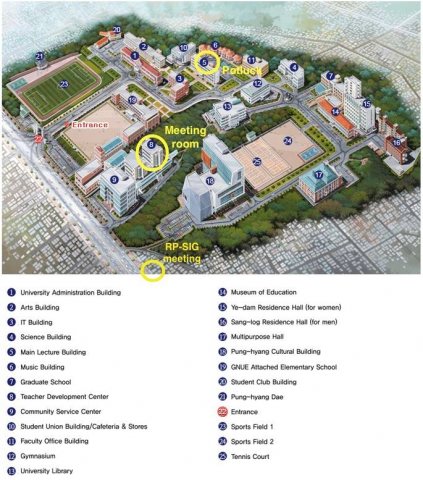
Gwangju-Jeonnam Chapter August Meeting
.
––– No Reflective Practice Session Scheduled –––

––– MAIN MEETING SCHEDULE –––
Time: 2nd Saturday, August 11, 2018, 1:45ㅡ5:00 pm
Location: Gwangju National University of Education (GNUE), Teacher Training Center (교사교육센터) 1st Floor; Room 811. Detailed directions HERE.
1:45 pm: Sign-in and Meet-and-Greet (Admission: Free for newcomers. Membership welcomed.)
2:00ㅡ2:50 pm: Presentation: Part 1
ㅡ A Framework for Explaining Activities and Games to Learners with Limited English
ㅡ Andrew Griffiths (Daejeon Education Training Institute)
2:50ㅡ3:10 pm: Refreshment Break
3:10ㅡ4:00 pm: Presentation: Part 2
ㅡ A Framework for Explaining Activities and Games to Learners with Limited English
4:10ㅡ4:45 pm: Swap-Shop Presentations
Share your Teaching Ideas, Classroom Activities, and Teaching Wisdom with the group.
(Everyone is encouraged to share [up to 5-6 min. each]. Short tidbits are welcomed. Handouts also welcomed.)
4:45 - 5:00 pm: Announcements / Drawing for Door Prizes / Closing
(After-Meeting Dinner for those who wish to participate. Venue: TBA)
Session Summary
A Framework for Explaining Activities and Games to Learners with Limited English
Andrew Griffiths
BACKGROUND
1. What is the problem?
A lot of low-level students simply cannot follow an English class delivered in English. This affects our ability to teach effectively, and limits their exposure to English, which in turn affects their listening ability. In my experience, the explanations of games and activities seem to cause the most difficulties.
2. Why are game and activity explanations more difficult than other parts of a class?
My educated guess is that other parts of the class follow a consistent routine and use consistent language, so students know what to expect and can "catch on," but because we have to explain each game in a unique way (since each game is unique), we can’t have the same consistency. Games are also complex entities, and as a result game explanations can become overlong, too teacher-centered, and can bore students.
3. How could we make game or activity explanations more effective?
Firstly, take the good things from the other parts of class – the consistent routine and language – and transfer that consistency into the game or activity explanation. In other words, explain games the same way, every time, and so give the students a chance to 'catch on." Secondly, engage them more. Find ways of asking more questions, and above all else, don’t talk for too long. The following framework demonstrates how to do these things.
THE FRAMEWORK
The framework is called "Aim, How, But," and is named after the three sections of the framework. Using the framework, almost any game can be explained in less than 3 1/2 minutes and will involve extensive student involvement to alleviate boredom.
The framework is an intuitive one; it corresponds to the natural structure of how games work. The framework emerged naturally during my teaching career while teaching low-level students and has only been formalized in the last few years.
Aim
The aim of any game can be understood as its "ultimate destination." For example, the aim of football is to score more goals than the other team. The best way to identify an aim is to work out where the biggest "assah!" moment occurs in a game. The aim should be stated simply, repeated with stress and expression. An ICQ is also useful at the end.
How
This can be understood as the way to the destination. The route should be shown step by step from the aim downwards. For example, the first step to understanding football is to know that a football (soccer) team scores goals by putting the ball into the other team’s net using only feet or the head. From this, concepts such as passing and shooting can be explained, leading to concepts of defending and goalkeeping, leading to concepts of team strategy, and so on.
Demonstrations are important here. Many teachers talk too much during this section, describing what is going on, which causes a conceptual and linguistic overload for the students. We should show students how to play the game rather than telling them. By demonstrating the game we can use more target language, and intersperse our demonstration with ICQs. If possible, demonstrations should involve the whole class.
But
This can be understood as the things that will stop you from getting to your destination and follows naturally from the "How." For example, in football, handling the ball will stop you from scoring and instead result in a yellow or red card. Kicking the ball out of play will stop you from scoring and cause a throw-in or goal kick. And kicking your opponent won’t end well either!
Repetition is important here: students need to hear the rules at least twice or even three times to let them sink in. Only the most important rules should be stated, and we should always invoke and enforce the golden rule of English classroom games, which is "if you don’t use the target language, you will lose the game."
OUTCOMES
This framework has proved incredibly successful in my classes, and other teachers I have worked with have reported similar results. Most students eventually "catch on" and feel less bored. The framework also reduces explanation time, which means students have more time to play. Finally, a lot of teachers – and people – themselves have problems explaining games even if they know how to play them, and so the framework can help teachers conceptualize the natural structure of a game.
The success of the framework depends on two things: time and consistency. Students need to hear the framework for a few weeks before they start to see the pattern of the explanation, and the framework must also be used consistently to give students a chance to get used to it.
NEXT STEPS
I believe that the process towards perfecting the framework will always be an ongoing one – thus, I welcome any amendments, augmentations, or pieces of advice that you can offer me. The sole purpose of developing this framework has been to ensure that our learners can get more opportunities to learn, and I am eager to hear any way of making it work better.
The Presenter

Andrew Griffiths is a teacher trainer for the Daejeon Education Training Institute, which is affiliated with the Daejeon Office of Education. He has been teaching for almost ten years and specializes in teaching techniques of producing effective classroom English. He holds an MA from the University of Nottingham. Email: andrew.griffiths1982@gmail.com
___________________________
Photo: The Gwangju National University of Education (GNUE / 광주교육대학교), Teacher Training Center (교사교육센터), venue for our main meeting ㅡ 1st floor, Room 811.




